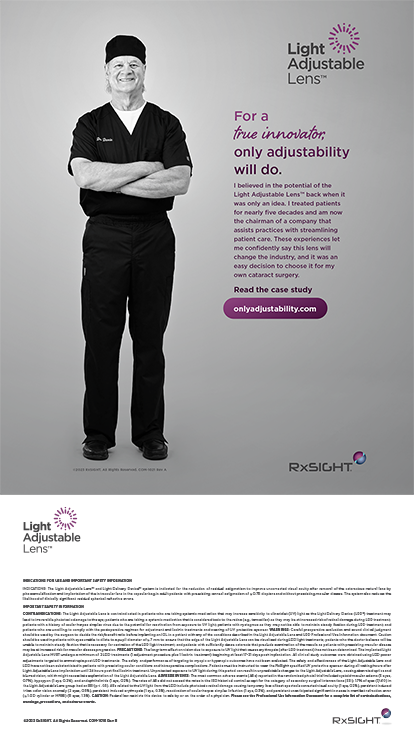Laser cataract extraction has changed drastically over the past few years. The only FDA-approved technology commercially available is the Dodick Laser Photolysis system (A.R.C. Laser Corp., Salt Lake City), which uses an indirect Nd:YAG laser to create a plasma wave that emulsifies the nucleus. Because this modality produces no heat, an irrigating sleeve is not required, and the size of the incision may be reduced to between 0.90 mm and 1.20 mm. Several surgeons worldwide now use this technology to perform 80% to 90% of their cataract extractions, but each has cultivated his own technique.
INDIVIDUAL EXPERIENCES
The cataracts that Rajeev Raut, MD, of Pune, India, treats generally range in density from grade +4 to +6. His pioneering technique permits him to use laser photolysis for almost all of his cataract cases. Dr. Raut neither hydrodissects nor hydrodelineates the lens nucleus in order to avoid internally rotating it. He uses the posterior capsule to stabilize the nucleus as he drills a hole through its center with the laser/aspiration probe. Because the nucleus does not rotate, he is able to apply laser energy to the exact spot he chooses to create a nuclear pit. Next, Dr. Raut places the laser probe at the center of the pit he has created and applies energy, which shatters the nucleus into pieces that he can easily remove.
Ivan Zerdab, MD, of Chambery, France, employs laser photolysis in greater than 90% of his cataract cases. He makes two paracentesis incisions, after which he performs a continuous curvilinear capsulorhexis. Dr. Zerdab grades nuclei on a scale of +1 to +4 based on the amount of BSS (Alcon Laboratories, Inc., Fort Worth, TX) that he can inject at the nuclear core. If the nucleus is a +4 (accepts no fluid), he proceeds directly to the Raut technique. If the nuclear core accepts fluid, then Dr. Zerdab hydrodissects and hydrodelineates aggressively. He uses the combination laser/aspiration probe set on a repetition rate of two to remove the core of the lens. Next, he chops the remaining shell using an irrigating Sinskey hook. He can remove lenses with densities as high as +3 within 3 minutes.
Wolfram Wehner, MD, of Nuremberg, Germany, developed a technique for cataract extraction using Dodick Laser Photolysis. He creates a large capsulorhexis and uses aspiration to elevate the lens. After tilting the nucleus out of the bag, he back-cracks it by means of a specially designed irrigating chopper called the Wehner Spoon. This device increases procedural safety by helping him to manipulate lens fragments as he directs irrigating fluid toward the posterior capsule. Dr. Wehner concludes by injecting the rollable 1.00-mm plate lens from Acri.Tec GmbH (Berlin). He uses this technique for more than 90% of his cataract procedures, which he completes through two incisions sized approximately 1.00 mm.
PERSONAL ESTIMATION
I have trained many residents, fellows, and attending surgeons to use the Dodick Photolysis System. At the Manhattan Eye, Ear & Throat Hospital, we have experienced fewer complications when training with this technology than with phacoemulsification. I have found that this system appears to cause less turbulence in the anterior chamber. Because the surgery is bimanual, surgeons who normally employ a two-handed technique may adapt more readily to the system.
Iman Ali Pahlavi, MD, is Residency Program Director in Ophthalmology at the Manhattan Eye, Ear & Throat Hospital and is affiliated with New York University School of Medicine. She holds no financial interest in the products mentioned herein. Dr. Pahlavi may be reached at (212) 838-9200; iman@dodick.com.


